Eastern Regional Station, Kalyani
Historical Background The Eastern Regional Station (ERS) of National Dairy Research Institute (NDRI) was established in February 1964 at the Central Dairy in Calcutta. In September, 1965; a herd of 95 Red Sindhi cattle were transferred from NDRI, Karnal to ERS. These animals were initially stationed at the State Livestock Farm, Kalyani; and were then shifted to the Milk Colony, Haringhata in the year 1966. The office of the ERS was also shifted from Calcutta to Kalyani during 1966 and was located in the Administrative Building of Kalyani University. Kalyani was then a small industrial town located at a distance of about 50 km north of Calcutta. After a year, it was shifted to the newly established Bidhan Chandra Krishi Viswavidyalaya premises at Kalyani. Laboratory facilities were gradually developed there. The Regional Animal Nutrition Research Centre of the ICAR till then located at Haringhata was also merged with the ERS of NDRI with effect from 1st June, 1968.
Research on various disciplines of dairying e.g. Dairy Chemistry, Dairy Bacteriology, Dairy Technology, Animal Nutrition, Dairy Economics and Extension were initiated. Crossbreeding of the indigenous stock with Holstein-Friesian bulls was started at around 1972. A Dairy Demonstration Unit was established for educating the farmers in scientific dairy farm management practices. An extensive exercise was also carried out to determine the nutritive value of tree leaves and field grasses of the eastern region.
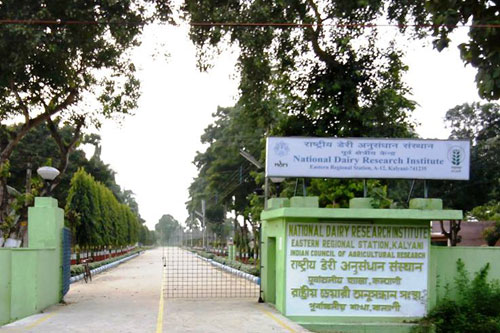
In 1978, the Government of West Bengal allotted 100 acres of land for the eastern regional station in A-12 Block of Kalyani. Cattle shed, laboratory buildings and staff quarters etc. were gradually built up there. The unused barren land was developed in to a fodder farm to provide quality fodder to the high yielding crossbred cattle maintained at this centre. The main thrust was to evolve a high yielding genotype suitable to the warm-humid subtropical agro-climatic condition of eastern India. Induction of Karan-Fries and Jersey x Tharparkar crossbred cows to the cattle herd of ERS on transfer from NDRI, Karnal was an important step in this direction.
The development of infrastructure was nearly completed in May, 1987. The research activities started in full swing in the second half of 1987 from the new campus. The research work during the period of 1964-1972, was mainly related to Animal Nutrition, that during the period of 1972-1976, was related to Animal Nutrition, Dairy Chemistry, Dairy Bacteriology and Dairy Technology, that during the period of 1977-1985, was related to Animal Nutrition, Animal Breeding, Soil Science, Dairy Economics and Dairy Extension, that during the period of 1986-1991, were related to Animal Nutrition, Livestock Production and Management, Animal Breeding, Forage production, Dairy Economics and Statistics and Dairy Extension and that during the period of 1992-1997, were related to Animal Nutrition, Livestock Production and Management, Animal Breeding, Forage production, Dairy Economics and Statistics and Dairy Extension. Dairy Biotechnology section was established and started functioning since 2006-07. The regional station has effective infrastructure facilities like Dairy Farm, Fodder Farm, Library and Computer Unit to support research and extension activities
| Year | Description |
|---|---|
| 1964 | Established in February 1964 at the Central Dairy in Calcutta. |
| 1965 | A herd of 95 Red Sindhi cattle were transferred to ERS from NDRI, Karnal |
| 1966 | The office of the ERS shifted from Calcutta to Administrative Building of Kalyani University. |
| 1967 | Shifted to newly established Bidhan Chandra Krishi Viswavidyalaya premises at Kalyani. |
| 1968 | The Regional Animal Nutrition Research Centre (ICAR), Haringhata, was merged with ERS |
| 1978 | The Govt. of W.B. allotted 100 acres of land for the ERS in A-12 Block of Kalyani. |
| 1979-86 | Infrastructure e.g.Cattle shed, Fodder farm Lab buildings, quarters etc were gradually built. |
| 1987 | The development of infrastructure was nearly completed in May, 1987. |
| 2002 | The new Administrative Block was built |
| 2006 | The Machine Milking facility has been introduced. |
| 2007 | Established Animal Biotechnology lab. |
| 2014 | Established Animal Physiology and Reproduction labDiploma in Animal Husbandry and Dairying started |
Kalyani is situated at 22° 58’30″N Latitude and 88° 26′ 4″ E Longitude. Kalyani is located at the lower Gangetic basin of West Bengal in Nadia district, 48 km north from Kolkata and is well connected by rail and road. ERS is around 2 km away from the Kalyani railway station. The climatic condition is hot humid. The average annual maximum temperature is 320C and the minimum temperature is 200C. The maximum humidity is 91% and minimum humidity is 58%. The annual rainfall is around 1250 mm.
- Identification of problems related to dairy production and management in eastern India
- Strategic and applied research for improvement of production, management and economic aspects of dairying under changing climatic condition in the region.
- Maintenance of superior germplasm for obtaining optimum productivity in dairy animals.
- Transfer of technology and awareness development through training, demonstration and extension services.
Eastern Regional Station of NDRI has three major sectors viz. Research, Administration and Service Sections. All the three sectors are controlled by the Head, while the sections under these sectors are under the supervision of respective Section Incharges. The detail lay out is presented below.
Head
| Research Laboratories | Administration | Supporting Section/cells |
|---|---|---|
| Animal Nutrition | Purchase & Central Store | Research Coordination Cell |
| Livestock Production &Management | Cash & Bill Section | Cattle Yard |
| Animal Breeding | Personnel | Fodder Farm |
| Animal Biotechnology | - | Computer Cell |
| Physiology and Reproduction | - | Estate Section |
| Dairy Economics | - | Library |
| Dairy Extension | - | Academic Cell |
Staff Strength
| Category | Number |
|---|---|
| Scientific | 11 |
| Technical | 8 |
| Administrative | 8 |
| Supporting Staff (Group D) | 16 |
| Total | 43 |
General Administration:
| Name | Designation |
|---|---|
| Shri Sukhdev Singh | Assistant Administrative Officer |
Scientists:
| Name | Designation |
|---|---|
| Dr. S.M. Deb, Ph.D. | Head |
| Dr. T. K. Dutta, Ph.D. | Principal Scientist (Animal Nutrition) |
| Dr. S. K. Das, Ph.D. | Principal Scientist (Animal Biotechnology) |
| Dr. Ashok Santra, Ph.D. | Principal Scientist (Animal Nutrition) |
| Dr.Champak Bhakat, Ph.D | Principal Scientist (LPM) |
| Dr. Ajoy Mandal, Ph.D | Principal Scientist (Animal Genetics & Breeding) |
| Dr. D. K. Mandal, Ph.D | Principal Scientist (LPM) |
| Dr. Anupam Chatterjee, Ph.D | Principal Scientist (Animal Nutrition) |
| Dr. Mohan Mondal, Ph.D | Senior Scientist (Animal Physiology) |
| Dr. M. Karunakaran, Ph.D’ | Senior Scientist (Animal Reproduction & Gynaecol.) |
| Dr. Asif Mohammad, Ph.D | Scientist (Dairy Extension) |
| Dr. Saroj Rai, Ph.D | Scientist (LPM) |
| Dr. Rajalaxmi Behera, M.V.Sc. | Scientist (AGB) |
Technical officers :
| Name | Designation |
|---|---|
| Mr. Alokesh Goswami,M.Sc. (Ag.) | Chief Technical Officer |
| Dr. Amitava Ghosh, M.V.Sc. (A.N.) | Chief Technical Officer |
| Dr. Somnath Dutta, M.V.Sc. (Repr. & Gynae.) | Asst. Chief Technical Officer |
| Mr. P. Saha, M.Sc.(DT) | Asst. Chief Technical Officer |
| Mr. M.L. Ghosh, B.Sc. | Technical Officer (T-6) |
| Mr. Dasrath Munjani | Technical Officer (T-5) |
| Mr. R. N. Neogi | Technician (T-1) |
| Mr. P. Roychowdhury | Technician (T-1) |
An area-specific mineral mixture (KALMIN-ERS) for livestock was prepared with Di-calcium phosphate (DCP), Zinc sulphate (ZnSO4), Copper sulphate (CuSO4), Cobalt sulphate (CoSO4) and Manganese sulphate (MnSO4) in the ratio of 3000:40:20:2:1 to ameliorate mineral deficiency of dairy animals. This mineral mixture is very effective to correct the reproductive problems of cattle/buffalo and goats and to maintain the sustainable production of animal.
Tree fodders commonly fed to animals in Arunachal Pradesh were identified and their nutritional composition was established. Salyx (Salyx humboltiana) and maar (Costanpsis sp.) were the best tree leafs/fodder (contained 14.5 & 12.7 % CP; 13.2 & 20.7 % cellulose; 59.3 & 60.2 % IVTDMD) for feeding to the livestock in Arunachal Pradesh.
- Fresh Azolla microphylla has been found to have potential to serve as a green supplement for the dairy cattle for the improvement in milk yield and growth performance without any adverse effect especially where/when green fodder availability is scanty. Supplementation of Azolla Meal improved the growth rate and feed conversion efficiency of growing crossbred cattle significantly. It can be utilized as good alternative source of protein and other essential nutrients for the ruminants.
- Sun dried Brewer’s Spent Grain meal have been evaluated to be an alternative protein source for ruminants improving the growth and milk production performance of cross bred cattle in an economic way.
- Quality of a good sizable proportion of wheat grain deteriorated during storage at FCI due to lack of proper storage facility and declared unfit for human consumption which is designated as animal feed grade wheat. Animal feed grade wheat may be used in the ration of growing cross-bred calves by replacing maize grain to formulate economize ration.
- A feeding device/appliance has been developed for calves which is much more effective as compared to conventional feeding troughs to minimize the feed/fodder wastage (25 – 30 %). One device is sufficient for 6-8 calves (upto 6 months of age) at a time for all types of feeding materials.
- In vitro cattle embryos were developed isolating immature oocytes from ovaries collected from slaughter house. Fetal skin fibroblast cells monolayer was prepared isolating skin cells from fetal skin. After monolayer formation the fibroblast cells were cryopreserved by vitrification method.
- The animals having less than 50% Jersey inheritance produced lowest 305DMY (2495.35±92.44 kg) and TMY (2948.68±121.01 kg) among all crosses and therefore, the animals having ? Jersey x ? Tharparkar genetic combination may be the best suitable genotype for obtaining the optimum productivity in this agro-climatic region.
- The repeatability model that includes direct genetic effect and permanent environmental effect due to dam, is considered as the most appropriate genetic model for analyzing the lactation traits of crossbred cattle.
- The incidence of sub clinical mastitis (SCM) was increased with the parity of the animals with highest level of somatic cell counts (SCC) in last lactation. The higher incidence was observed in hind (59.23%) in comparison to fore (50%) quarter. Animals calved during rainy season may be out of heat stress but humidity and excess moisture make them more susceptible to infections, having a greater number of somatic cells count level.
- Study was conducted in six states (West Bengal, Bihar, Orissa, Jharkhand, Sikkim, and Nagaland) of the eastern/NEH region for impact analysis of dairy co-operatives on member house hold families. Overall 74 % members and 63 % non-member milk producers have knowledge of different dairy production technologies.
- Semen from Black Bengal Bucks aged between 2 – 4 years was successfully collected by artificial vagina method and it was found that Tris-egg yolk citrate buffer and Tris-egg yolk citrate buffer with glycerol maintained sperm motility for more than 72 h (52.33%) for buck semen in Black Bengal goats.
- Crossbred anestrus heifers were treated with metastin (peptide of 10 amino acid long) @ 200µg per animal intravenously. The appearance of a biphasic LH peaks was common in all responded animals. The 80% estrous cycles in the present investigation showed three E2 peaks; the first appeared on day 16 of the estrous cycle, second on day 3 before the day of estrus and third peak was on the day of estrus.
- Developed and designed a cheaper intranasal spray device for Kisspeptin-10 specific to bovine. Kisspeptin-10 (kp-10) in lesser dose through intranasal route than i/v can be potent secretagogue for GnRH release thereby economic drug for GnRH (and so LH and FSH) release from CNS.
- The study on clean milk production revealed that course correction advice to the farmers regarding adoption of appropriate hygienic measures and providing better ventilation and drainage facilities in the cattle shed had better impact on milk quality.
Basic Animal Nutrition Lab
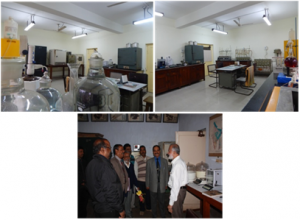
Nutritional Biotechnology Lab

Micro Nutrient Lab

Animal Biotechnology Lab
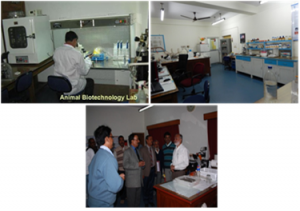
Physiology & Reproduction Lab
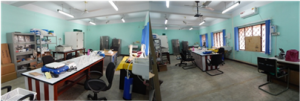
Animal Breeding & Computer Lab
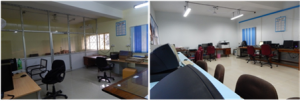
Livestock Production & Management
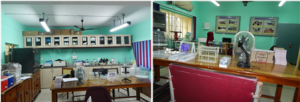
Dairy Extension
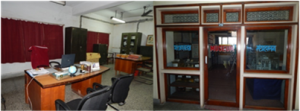
Conference Room

| Sr. No. | Project Title | Project Investigator | Duration |
|---|---|---|---|
| Institute Projects | |||
| 1. | Dietary manipulation of rumen fermentation using tree leaves of north eastern India for improving growth performance in calves. | A. Santra | April’14- March’16 |
| 2. | Comparative nutritional evaluation and utilization of some newer feed resources in dairy cattle ration. | A.Chatterjee | April’14- March’17 |
| 3. | Influence of some managemental practices on incidence of subclinical mastitis and quality milk production in dairy cows. | C.Bhakat | Dec’13-Dec.’17 |
| 4. | Effect of supplement of area specific mineral mixture (KALMIN) on productive and reproductive performance in dairy animals. | M.K.Ghosh | April’14- March’17 |
| 5. | Cryopreservation of cattle oocytes and their post thawing embryo development through in vitro techniques | S.K.Das | April’14- March’17 |
| 6. | Development of genetic model for improving the selection efficiency of crossbred cattle at ERS, NDRI, Kalyani | A. Mandal | April’14- March’17 |
| 7. | Application of Kisspeptin, a Noble GnRH Secretagogue for Augmentation of Reproduction in Crossbred cows. | M. Mondal | April’14- March’17 |
| 8. | Development of suitable protocol for preservation of Bengal Goat semen. | M. Karunakaran | April’14- March’17 |
| 9. | Dairying in sustainable livelihood among the rural farm family at Nadia district of West Bengal. | S. Garai | April’14- March’17 |
| Externally funded Projects | |||
| 10. | Application of Endocrine Biotechniques for induction of mother-neonate Bonding in Mithun (Bos frontalis | M. Mondal | 2009-Dec.’14 |
| 11. | Onset of puberty and Induction of Estrus: Role of Kisspeptin (kiss1) in bovine Species (Mithun and Cattle)” – DBT sponsored Twinning Programme | M. Mondal | Mar’14-March’17 |
| Tribal Sub Plan | |||
| 12. | Upliftment of socio-economic condition of Tribal people through Integrated Livestock Farming in north eastern hill region/eastern part of India. | - | - |
The Cattle yard of the station maintains around 160 crossbred cattle. The cattle yard comprises of Calf shed, Heifer shed, Experimental animal shed, Milch animal shed, Milking Byre etc. which are being utilized for production, research as well as for hands on training, demonstration and orientation for the dairy farmers of the region on different aspects of scientific dairy farming.
The computer center maintains the database of cattle yard as well as the experimental data of various research projects. The institute has Internet connectivity (512 kbps) from ERNET through VSAT, which is useful for searching literature and references. The facility is used by Scientists, Students and staff of the Regional Station.
The library contains 1521 books, 3458 volumes of bound journals and other periodicals in the field of Dairying. Besides, Annual Reports of different Institutes and proceedings of various workshops and seminars are also available for reference. Presently 8 journals are subscribed.
Forage section is engaged in cultivation of quality fodder crops (including organic fodder) in about 30 hectare areas. The section manages harvesting and provides chaffed or unchaffed fodder crops to the farm animals. Besides cultivation of fodder crops, the section also has a mini workshop for regular servicing of agricultural machineries including tractors, chaff cutter etc. There is also an agri-meteorological observatory from where regular meteorological observations are recorded. There are about 700 plants of teak, sissam, etc. growing around the institute premises. Besides, there is a fodder herbarium for training and demonstration purpose. Recently, a feed milling plant is being installed at this campus for preparing the experimental concentrate formulations.
Guest house
The station has a small Guest House having three furnished air conditioned rooms with internet facility.
Hostels
Presently four ‘A Type’, partially B & C-type residential Quarters have been converted to Student Hostel for Boys and one D type quarter for girls.
Sports
Some indoor sports facilities have been developed such as badminton, table tennis, carom, and volleyball as outdoor game.
The eastern regional station regularly conducts various types of training programmes in different areas of dairy production. Training programmes on “Scientific Dairy Farming” for 15 days, “Artificial Insemination” for 42 days and “Animal Nutrition & Fodder Production” for one week for educated unemployed rural youth/progressive farmers are being organised every quarter for educating the rural mass on dairying. Field visits and orientation programmes are also organised for the farmers of Dairy Cooperative Societies and NGOs on request. Sponsored Training programmes are also organized in ERS, Kalyani campus.
- Back to previous page
- |
-
Page last updated date:24-03-2025 04:33 PM












